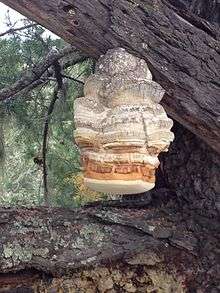Laricifomes officinalis
Laricifomes officinalis is a wood-decay fungus in the order Polyporales. It causes brown heart rot on conifers, and is found in Europe, Asia, and North America, as well as Morocco.[2] It is commonly known as agarikon, as well as the quinine conk because of its extremely bitter taste.[3][4] DNA analysis supports L. officinalis as distinct from the genus Fomitopsis.[5]
| Laricifomes officinalis | |
|---|---|
 | |
| Scientific classification | |
| Kingdom: | |
| Division: | |
| Class: | |
| Order: | |
| Family: | |
| Genus: | |
| Species: | L. officinalis |
| Binomial name | |
| Laricifomes officinalis | |
| Synonyms | |
|
Agaricum officinale (Vill.) Donk (1971) [1974] | |
The conks were once collected extensively for production of medicinal quinine, which they were thought to contain, because of the bitter taste of the powdered conk. However, they do not contain quinine, and have no anti-malarial properties.[6]
The distinctive conks can be large, as much as two feet long, hoof-shaped or columnar. They are soft, yellow-white when young, soon becoming white and chalky throughout. The decay is brown, cubically cracked, with thick white felts in large cracks. The taste of both conks and felts is bitter and distinct for this species. A single conk usually indicates complete cull. Infected trees can be habitat for snag-nesting species.[7]
Medicinal use
L. officinalis was used by the Ancient Greeks to treat consumption (tuberculosis) according to the writings of Pedanius Dioscorides in 65 AD,[4] and by some indigenous people to treat smallpox.[8] The presence of Agarikon at burial sites may indicate that its use was once widespread. The species epithet "officinalis" denotes an organism associated with herbalism or medicine.
Mycologist Paul Stamets has performed numerous investigations of the biological activities of Agarikon. Agarikon extracts have demonstrated antiviral activity against a range of viruses in vitro.[9] This activity has been specifically observed against pox family viruses,[10] HSV-1 and HSV-2, Influenza A, Influenza B, and Mycobacterium tuberculosis in vitro.[11]
Other researchers have identified novel chlorinated coumarins in the organism which demonstrated notably low minimum inhibitory concentrations against the Mycobacterium tuberculosis complex.[12]
Conservation
Wild Agarikon is only found in old-growth forests[13], and grows on conifers, particularly Douglas-fir (Pseudotsuga) and larch (Larix). Conservation of wild populations of L. officinalis is a concern because of loss of ancient forest habitat. Because it is difficult to maintain long-term genetic integrity of laboratory-grown strains, it is necessary to preserve the mushroom in the wild.
Ethnomycology
Laricifomes officinalis was important both medicinally and spiritually to indigenous peoples of the Pacific Northwest Coast of North America, such as the Tlingit, Haida, and Tsimshian. L. officinalis was referred to as the "bread of ghosts" in local languages, and carved fruiting bodies marked the graves of tribal shamans.[14]
References
- Kałucka, I.L. & Svetasheva, T. (2019). Fomitopsis officinalis. The IUCN Red List of Threatened Species 2019: e.T75104087A75104095. doi:10.2305/IUCN.UK.2019-3.RLTS.T75104087A75104095.en. Downloaded on 09 July 2020.
- Chlebicki, Andrzej; Mukhin, Viktor A.; Ushakova, Nadezhda (2003). "Fomitopsis officinalis on Siberian Larch in the Urals". Mycologist. 17 (3): 116–120. doi:10.1017/S0269915X03003057.
- Ginns, J. (2006). "Annotated Key to Pacific Northwest Polypores". Pacific Northwest Key Council. Retrieved 2011-04-17.
- Stamets, Paul (2005). "Medicinal Polypores of the Forests of North America: Screening for Novel Antiviral Activity" (PDF). International Journal of Medicinal Mushrooms. 7 (3): 362. doi:10.1615/intjmedmushr.v7.i3.210.
- Kim, Kyung Mo; Yoon, Yuh-Gang; Jung, Hack Sung (2005). "Evaluation of the monophyly of Fomitopsis using parsimony and MCMC methods". Mycologia. 97 (4): 812–822. doi:10.1080/15572536.2006.11832773. PMID 16457351.
- Arora, David (1986). Mushrooms Demystified. Ten Speed Press. p. 580.
- Hagle, Gibson, Tunnock. A Field Guide to Diseases & Insect Pests of Northern & Central Rocky Mountain Conifers. USDA Forest Service: 2003, pg 29
- Walker, Brett (May 1999). "The Early Modern Japanese State and Ainu Vaccinations: Redefining the Body Politic 1799-1868". Past & Present. 163 (1): 121–61. doi:10.1093/past/163.1.121. JSTOR 651171. PMID 22049584.
- Stamets, Paul (2005). "Medicinal Polypores of the Forests of North America: Screening for Novel Antiviral Activity". International Journal of Medicinal Mushrooms. 7 (3): 362. doi:10.1615/IntJMedMushrooms.v7.i3.210.
- Stamets, Paul (2005). "Antipox Properties of Fomitopsis officinalis (Vill.: Fr.) Bond. et Singer (Agarikon) from the Pacific Northwest of North America". International Journal of Medicinal Mushrooms. 7 (3): 495–506. doi:10.1615/IntJMedMushr.v7.i3.60.
- Stamets, Paul. "[Patent] Antiviral and antibacterial activity from medicinal mushrooms". Google Patents.
- Hwang, Chang (2013). "Chlorinated Coumarins from the Polypore Mushroom Fomitopsis officinalis and Their Activity against Mycobacterium tuberculosis". J Nat Prod. 76 (10): 1916–1922. doi:10.1021/np400497f. PMC 3851412. PMID 24087924.
- Stamets, Paul (2009-11-13). "The Search for Agarikon". Fungi Perfecti. Retrieved 2020-05-14.
- Blanchette, Robert A.; Compton, Brian D.; Turner, Nancy J.; Gilbertson, Robert L. (Jan–Feb 1992). "Nineteenth Century Shaman Grave Guardians Are Carved Fomitopsis officinalis Sporophores". Mycologia. 84 (1): 119–124. doi:10.2307/3760412. JSTOR 3760412.
External links
| Wikimedia Commons has media related to Laricifomes officinalis. |
- Index Fungorum
- USDA ARS Fungal Database
- Brown Trunk Rot, Trees, insects and diseases of Canada's forests, Natural Resources Canada
- Agarikon, Cornell University Mushroom Blog
